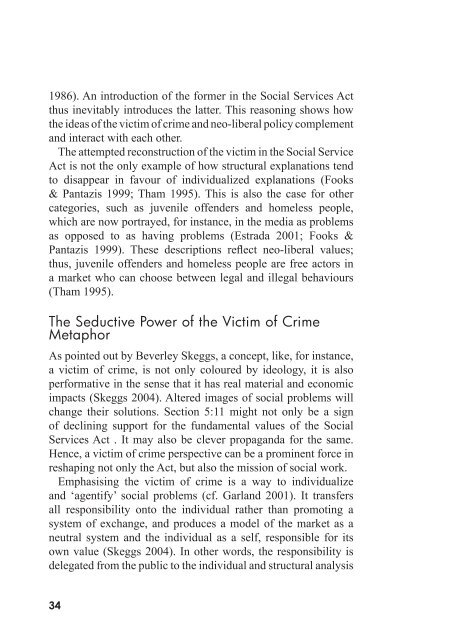Thinking with Bevereley Skeggs - Stockholms universitet
Thinking with Bevereley Skeggs - Stockholms universitet
Thinking with Bevereley Skeggs - Stockholms universitet
- No tags were found...
You also want an ePaper? Increase the reach of your titles
YUMPU automatically turns print PDFs into web optimized ePapers that Google loves.
1986). An introduction of the former in the Social Services Actthus inevitably introduces the latter. This reasoning shows howthe ideas of the victim of crime and neo-liberal policy complementand interact <strong>with</strong> each other.The attempted reconstruction of the victim in the Social ServiceAct is not the only example of how structural explanations tendto disappear in favour of individualized explanations (Fooks& Pantazis 1999; Tham 1995). This is also the case for othercategories, such as juvenile offenders and homeless people,which are now portrayed, for instance, in the media as problemsas opposed to as having problems (Estrada 2001; Fooks &Pantazis 1999). These descriptions reflect neo-liberal values;thus, juvenile offenders and homeless people are free actors ina market who can choose between legal and illegal behaviours(Tham 1995).The Seductive Power of the Victim of CrimeMetaphorAs pointed out by Beverley <strong>Skeggs</strong>, a concept, like, for instance,a victim of crime, is not only coloured by ideology, it is alsoperformative in the sense that it has real material and economicimpacts (<strong>Skeggs</strong> 2004). Altered images of social problems willchange their solutions. Section 5:11 might not only be a signof declining support for the fundamental values of the SocialServices Act . It may also be clever propaganda for the same.Hence, a victim of crime perspective can be a prominent force inreshaping not only the Act, but also the mission of social work.Emphasising the victim of crime is a way to individualizeand ‘agentify’ social problems (cf. Garland 2001). It transfersall responsibility onto the individual rather than promoting asystem of exchange, and produces a model of the market as aneutral system and the individual as a self, responsible for itsown value (<strong>Skeggs</strong> 2004). In other words, the responsibility isdelegated from the public to the individual and structural analysis34
















